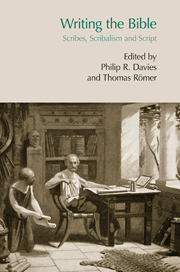Book contents
- Frontmatter
- Contents
- Abbreviations
- 1 Introduction
- I Writing in the ancient world
- II Hebrew Bible and early Judaism
- 4 The dissemination of written texts
- 5 Genesis: a composition for construing a homeland of the imagination for elite scribal circles or for educating the illiterate?
- 6 The “Prophets” as scriptural collection and scriptural prophecy during the Second Temple period
- 7 From prophet to scribe: Jeremiah, Huldah and the invention of the book
- 8 Instituting through writing: the letters of Mordecai in Esther 9:20-28
- 9 The Scribe and his class: Ben Sira on rich and poor
- III Early Judaism and early Christianity
- Index of biblical and other ancient sources
- Author index
5 - Genesis: a composition for construing a homeland of the imagination for elite scribal circles or for educating the illiterate?
- Frontmatter
- Contents
- Abbreviations
- 1 Introduction
- I Writing in the ancient world
- II Hebrew Bible and early Judaism
- 4 The dissemination of written texts
- 5 Genesis: a composition for construing a homeland of the imagination for elite scribal circles or for educating the illiterate?
- 6 The “Prophets” as scriptural collection and scriptural prophecy during the Second Temple period
- 7 From prophet to scribe: Jeremiah, Huldah and the invention of the book
- 8 Instituting through writing: the letters of Mordecai in Esther 9:20-28
- 9 The Scribe and his class: Ben Sira on rich and poor
- III Early Judaism and early Christianity
- Index of biblical and other ancient sources
- Author index
Summary
INTRODUCTION
Who was the implied intended audience of the book of Genesis? This seems like a straightforward question, but it is not; we have little to no evidence concerning scribal schools and the production of literature within late Judahite and Judean culture and society and we also cannot know how the book might have grown and changed over time. Different audiences may have been envisioned at different stages. Many assertions can be made, but in the end, the lack of evidence leads us to deduce and infer a plausible answer or set of answers to the question of intended audience from internal information we deem to provide relevant clues in the quest. In this presentation I will explore preliminary factors I think need to be included in any attempt to understand why Genesis was written and for whom.
In his most recent book on scribal culture and the creation of the Hebrew Bible, K. van der Toorn (2007) has made a number of assertions that can helpfully focus our reflection over the intended audience of Genesis. “Scribes wrote for scribes. To the public at large, the books of the Bible were icons of a body of knowledge accessible only through the oral instruction presented by religious experts” (ibid.: 2). “The Bible is a repository of tradition, accumulated over time, that was preserved and studied by a small body of specialists” (ibid.: 5).
- Type
- Chapter
- Information
- Writing the BibleScribes, Scribalism and Script, pp. 47 - 66Publisher: Acumen PublishingPrint publication year: 2013

